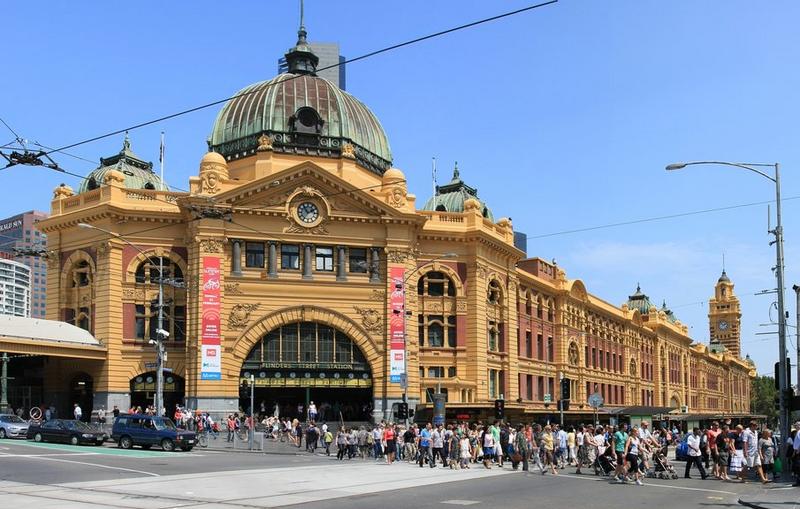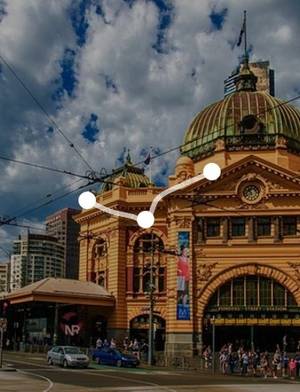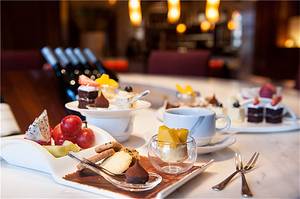Melbourne City Highlights
1 cities |
12 attraction(s) |
total distance 25
km
 TIPS
TIPS
Day1
Day2
Day1: Melbourne
7 attraction(s) ·
6 km
1
Flinders Street Station is one of Melbourne's largest and busiest train stations, as well as one of the buildings left behind from the Victorian era. As the first railway station in Melbourne, it serves as the central station for local railway lines. Its grand architectural style is very attractive and easily recognizable. Located in the city center, the station's unique location facing Federation Square and St. Paul's Church has become one of Melbourne's most important cultural centers. The entire station is built with yellow stone, and the bronze dome is one of its greatest features. When night falls, the station is illuminated by dim yellow lights and looks especially beautiful. As far as the eye can see, the magnificent buildings give people a peaceful and beautiful feeling. Melbourne residents often meet under the station's clock, which has become an important part of their lives. To experience the charm of Flinders Street Station, it is recommended to visit at night when you will surely be amazed by its unique classical beauty.
1
km
2
Fed Square is located in the center of Melbourne, Australia. It covers an area of 3.2 hectares and is adjacent to the Yarra River. The unique architectural style exudes the charm of Australian Aboriginal culture. The square is a holy place for people to gather, and the tourist center is a focus. Various celebratory events are held here every year, including New Year's countdowns and live sports broadcasts. The history of the square can be traced back to the 1960s. After a large-scale reconstruction, it was put into use in 2002 as a mixed-use multi-functional place with 16 cafes, bars and restaurants, various shops, and tourist service centers. There are many attractions around the square, such as the Ian Potter Center, the Australian Centre for the Moving Image, the National Gallery of Victoria Children's Play area, and the Australian Commercial Art galleries Association, etc. Tourists can spend unforgettable time here. The Melbourne Visitor Center provides thoughtful services for tourists to understand tourism information in Melbourne and Victoria. Fed Square is a vibrant and culturally rich place that is worth visiting.
1
km
3
The English name for graffiti art, "graffiti," comes from Greek slang and represents the grassroots and original nature of this art form. Early graffiti primarily appeared in public places such as walls, subways, etc., with cultural connotations such as youth, rebellion, and non-mainstream, reflecting the voice of African Americans. It has certain associations with the pop art that emerged in the 1960s, but there are also significant differences: Pop artists generally have received professional painting training, while graffiti artists are mostly from poor backgrounds. It wasn't until 1973 that graffiti art first received official exhibition and artistic recognition. Victoria, Australia's Melbourne has strict anti-graffiti laws, which means that young graffiti artists like to create in alleyways. Adrian Doyle is the founder of graffiti art in the area and a successful artist. Hosier Lane is a iconic street art alley in Melbourne's central business district with graffiti changing fastest. Spray painting and pasting are the main ways of graffiti, including paintings, artistic fonts, various posters, flyers, handicrafts, etc. To truly touch the territory of graffiti, you need to stand in the streets and alleys and appreciate it.
2
km
4
The Royal Exhibition Building is a Victorian-era building constructed in the late 19th century for the world exposition. In 1901, it became the meeting place for the Australian Parliament. For 100 years, the Royal Exhibition Building has been used for various events. Together with the surrounding Carlton Gardens, it is listed as a World Heritage Site. The building is one of the few remaining 19th-century exhibition buildings in the world and the only one that has survived to this day.
2
km
5
Public gallery with vast, varied collection of noted Australian and international art and artefacts.
1
km
6
The Yarra River, located in the center of Melbourne, is a popular tourist and leisure destination. In the evening, you can stroll along the riverbank and enjoy the beautiful scenery of Melbourne at night. Take a rest in the restaurants and bars along the way and experience the comfort of food and drink. At the same time, the buildings on both sides of the river have different architectural styles, which bring you different visual impacts. The Yarra River is a great place to make you happy, and it is also an excellent place to taste the cultural charm of Melbourne.
2
km
7
This market, which began in the mid-19th century, has now become the largest open-air market in Australia and even in the southern hemisphere. Here you can find everything, whether it's seafood, fresh meat, vegetables, fruits, or clothing, shoes, souvenirs, etc. If you can make it in time, you can also take advantage of the discounts on fresh fruits, vegetables, and meat before the market closes, and get them at affordable prices. The food night market on Wednesday nights is not to be missed. The night market in 2014 is from July 9th to August 26th, and every Wednesday night from November 5th to March 25th the following year, from 17:00 to 22:00. The night market not only has delicious food, but also bars, clothing, art and other goods, and there are live band performances, which are definitely worth a visit.
Day2: Melbourne
5 attraction(s) ·
17 km
1
Historic 26-hectare site in city centre with model Tudor village, tree-lined walking paths & cafes.
2
km
2
Whether you're just arriving at the train station, strolling along the street, or passing by on a tram, you can't miss this church located at the corner of Flinders St and Swanston St. In this new Gothic-style building, the authors' rich and ancient history and cultural heritage are preserved. Stepping through the heavy wooden doors, you'll be drawn in by the beauty of every stained glass window. Here, you can fully appreciate and immerse yourself in the beautiful scenery that this church has to offer.
2
km
3
36-hectare botanic garden founded in 1846, planted with Australian species and non-native gardens.
5
km
4
St. Kilda Beach is located at the northeast corner of Port Phillip Bay, about 6 kilometers from the city center. It is one of the most popular beaches in Melbourne, with many palm trees and white sandy beaches. St. Kilda Beach is a great place for surfing, sailing, and beach volleyball, attracting many enthusiasts to gather here.
10
km
5
In Australian tourism, getting close to animals is a major highlight. You can enter the enclosures of emus and kangaroos to get closer to them; you can also watch sea lions and penguins swim gracefully underwater; if you're lucky, you can even observe polar bears up close through glass. In addition, the park's green environment has its own unique flavor, with various birds freely roaming on the lawns, including peacocks, as if they had escaped from their cages.































